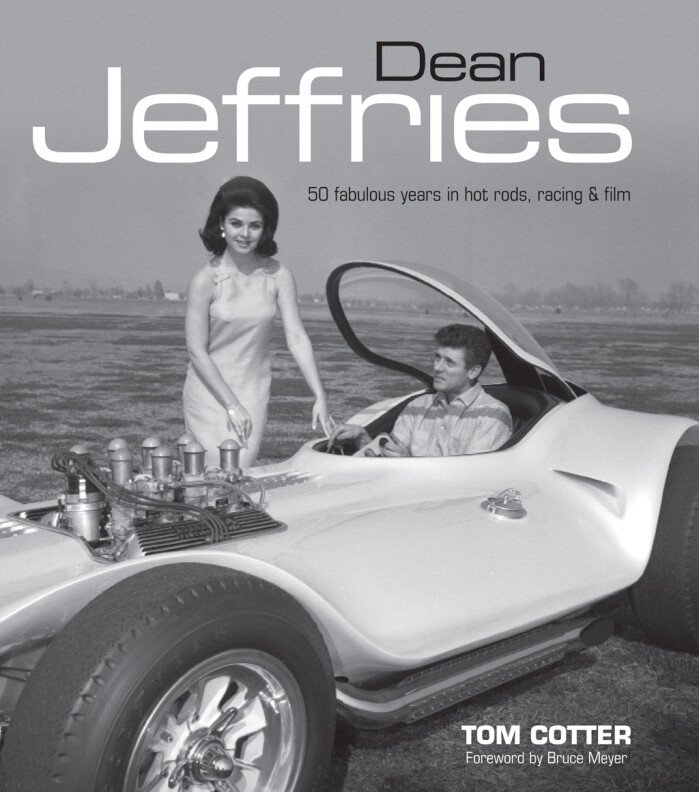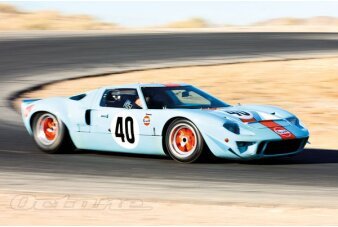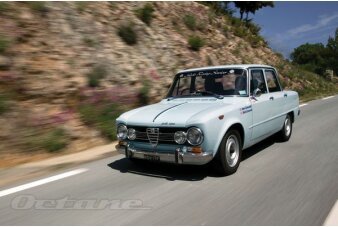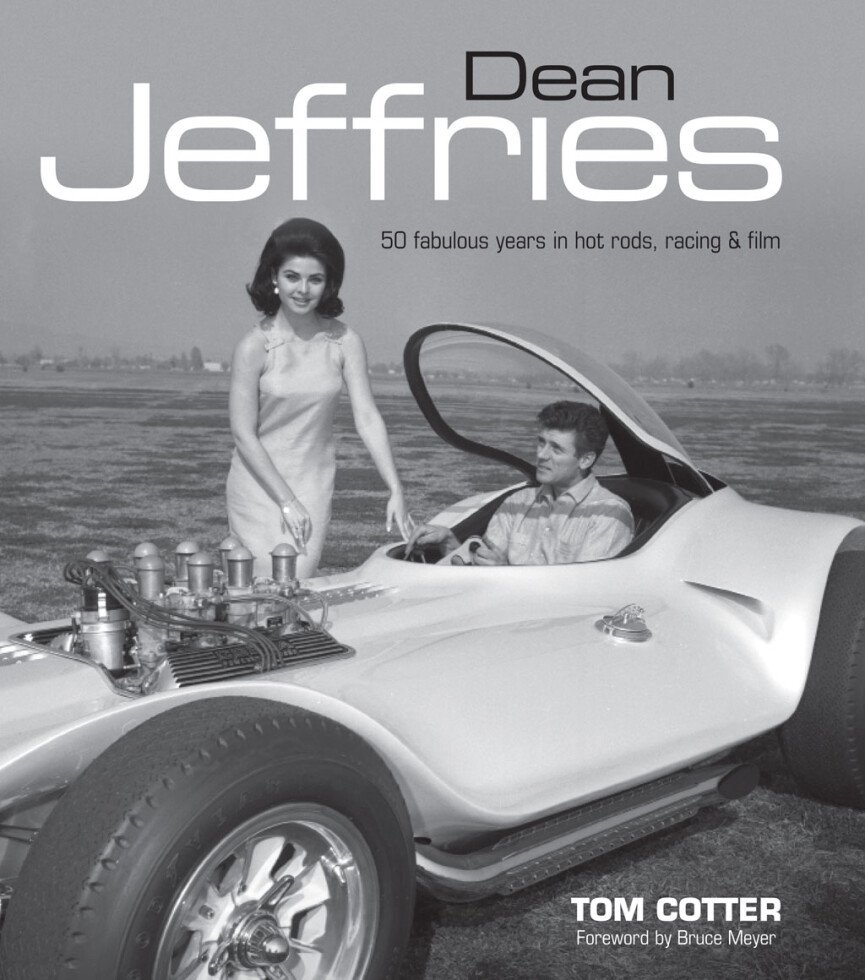Book Preview: Dean Jeffries: 50 Fabulous Years in Hot Rods, Racing, and Film

Dean Jeffries: 50 Fabulous Years in Hot Rods, Racing, and Film
by Tom Cotter
ISBN-13: 978-0-7603-3346-4
Hardcover: 192 pages
Publisher: Motorbooks; March 15, 2009
Retail: $40.00 US
If you’re not familiar with the career of Dean Jeffries, you may not realize how prolific he has been, or how many famous movie and television cars were his doing. It’s not completely surprising if you’re not familiar with his name, though, since Jeffries was never big on self-promotion. From pinstriping to stunt work to racing and custom car design, he has had his hand in just about every aspect of the custom scene. Just as monumental as his talent, though, are his feuds – most notably with George Barris, though there have been others. As Tom Cotter explores in Dean Jeffries: 50 Fabulous Years in Hot Rods, Racing, and Film, Jeffries is a bit rough around the edges, with not-so-nice things to say about everyone from racer A. J. Foyt to Bill Cosby. This is not a book to read aloud to your 5-year old son, unless you want him repeating some of the more colorful language.
It seems fitting, given the subject matter, that this book be a bit rough around the edges itself. There is a lot of very interesting content, to be sure: colorful anecdotes, fantastic photos, inside information, and background on the life of the man behind the cars. Unfortunately, that detail can sometimes obscure the larger picture, and Cotter’s obvious admiration for the man is, at times, distractingly heavy-handed. While I appreciated some of the information on Jeffries’ life and his relationship with his wife, Row, Cotter says that this relationship “became the most important part of the story” for him. The die-hard Jeffries fan would probably appreciate this more personal information, but for those reading the book looking only for cool cars and the stories behind them, it feels like overkill. I did find myself wishing at times that more detail had been given to a car, and a bit less to Jeffries as a person.
I certainly wouldn’t skip the book just because it can feel uneven in parts, though. Jeffries’ famous cars are generally well covered (both in text and photos), and the accompanying anecdotes are thoroughly entertaining. And, really, given Jeffries’ impressive talent and achievements, a touch of hero worship can be forgiven. This really is a fun book, above and beyond everything else. The history never feels dry or drawn-out, and the stories are never dull (though, coming from his life, they wouldn’t be). Though a bit unpolished, this book does a solid job of capturing the essence of Dean Jeffries and making this underrated artist accessible to a wide audience. If you’re unfamiliar with the work of Jeffries, you’re really missing out. While this may not be a complete listing of everything that Jeffries has done, it’s a great place to start if you’re looking for an inside look at both the man and the machines.
Dean Jeffries: 50 Fabulous Years in Hot Rods, Racing, and Film
by Tom Cotter
The Green Hornet’s Black Beauty
A car that stands out as one of Dean’s all-time favorites is the Black Beauty, a modified 1966 Chrysler Imperial that he constructed for the television series The Green Hornet. Ironically, very few share his excitement about the car.
Black Beauty didn’t achieve the cult status of other television series cars, such as the Batmobile or the Monkeemobile. For this, Jeffries has a simple explanation.
“They messed up,” he said. “The car was black and only used for night shots. You could never see it.”
The Green Hornet only came out to battle the evil villains after the sun was set. So the black car was barely visible to viewers watching the program from their living room couches.
That’s a shame, according to Jeffries, because the car featured numerous styling features that he believes would have been popular if only the show were filmed in daylight.
“You ended up with a car you couldn’t see,” Jeffries said. “None of the special effects could be seen.”
Features built into the Black Beauty rivaled James Bond’s Aston Martin built for the 007 series. The four-door sedan featured a grille-mounted cannon and a pair of rocket launchers fitted below each headlight. Each headlight could be rotated to three positions: regular clear sealed beams, red lights for clandestine nighttime driving, and the covered headlight mode.
The rear of the Black Beauty had taillights that flipped up to reveal rockets and flame throwers. Also, small brushes could be extended down to cover up tire tracks when driving on unpaved services.
The car’s modifications included a completely restyled front and rear end. Much to Jeffries’ chagrin, The Green Hornet producers requested the car be painted in gloss black and trimmed in lime green.
“The car was so loaded up with electric mechanisms [that] I wired it with a 24-volt aircraft system,” Jeffries said. “I had to purchase surplus aircraft supplies. The wiring systems are very complicated.”
The first Black Beauty was built in just two weeks because it was needed before filming could begin. A second was eventually constructed. It toured the country promoting the show. (Interestingly, Jeffries hired his mother and father to truck the Black Beauty to car shows around the United States.)
Black Beauty No. 1 is owned by the Petersen Automotive Museum and is used for display on occasion. The second version is owned by a collector in Florida who apparently has restored the car cosmetically. But according to Jeffries, the new owner still has his work cut out for him.
“He can’t figure out the wiring,” he said. “I absolutely would not have chosen a four-door sedan. It was an old square box of a car, which is why I cut the bumpers off and threw them away.
“It was the Green Hornet’s car, but it just wasn’t zoomie.”
The Monkeemobile
Ask any baby boomer about TV cars of the 1960s, and he or she will begin to rattle off names like the Batmobile and the Munster Koach. Cars played a major role in the creation of television programs of the day, especially shows with weak story lines.
Certainly a car that sits high on anyone’s list of iconic TV cars is the Monkeemobile. Its secret? It appealed to fans in several categories. First, it was the car that transported the Hollywood-fabricated rock-and-roll group The Monkees to all sorts of capers and shenanigans, which appealed to viewers of the weekly television series. Next, music fans saw the car was part of the band’s persona on record albums and on concert tours. And third, the car was just a cool classic rendition of a modern muscle car treated as a traditional hot rod, so even car enthusiasts who didn’t watch the Monkees’ television show and didn’t listen to the Monkees’ music still appreciated the band’s car because it was a real hot rod.
It’s amazing that a car whose design has stood the test of time so successfully for nearly 45 years was built by Dean Jeffries in just 10 days.
In 1966, Jim Wangers, who headed Pontiac advertising and coined the term “wide track” when referring to high-performance Pontiac models, was eager to promote the already successful GTO in magazines and on television.
“Jim Wangers was just a super guy,” Jeffries said. “He wanted to tie the Monkees and Pontiac together in the new show. So I got to know the right people—trying to climb that ladder and make a buck, you know—and they asked me for a couple of sketches. So I made them, and I got the deal.”
The Monkees used a Ford station wagon for practice before the show started, but once Jeffries got the OK from Pontiac and the show’s producers, he had to work quickly.
“I had to whip those things out because the show was big time,” Jeffries said. “So I got a couple of convertibles from Pontiac, and the first thing we did was throw the tops off. Then I cut the backs up and started to build the cars.
“We only built two Monkeemobiles; there were never any others.”
Jeffries said he worked night and day on the two Monkeemobiles, along with two helpers, and never left the shop; he slept upstairs over the office.
Since the donor GTOs were already convertibles, their chassis were already reinforced and stronger than the hardtop versions. Each car came equipped with a 389-cubic-inch engine and a two-speed automatic transmission.
Jeffries used the stock white Naugahyde Pontiac bucket seats in the front and middle rows of seating. He had a custom auto upholsterer from Lynwood fabricate a wraparound rear bench that was positioned where the trunk once existed.
Even though the Monkeemobile appears to be much longer than stock, the wheelbase is actually as it came from the factory. The car is physically longer, though, because 21 inches have been added to the front and 18 inches to the rear bodywork, exaggerating the GTO’s grille and taillights. Also the long Model T Touring–style roof visually adds length to the car.
The top doesn’t fold and is fabricated from 1x1-inch-square steel tubing. The same Lynwood upholsterer covered the tubing with white vinyl.
Jeffries retained the stock windshield, but he cut the posts and angled it up to a more vertical position, which blends together with the top and allowed for more headroom.
Jeffries originally installed a GMC 6-71 supercharger on the 389-cubic-inch engine, but it proved to have too much power for the casual driving necessary for the television show. So Jeffries gutted the supercharger on Monkeemobile No. 1 and installed a four-barrel carburetor inside.
Monkeemobile No. 2 retained the supercharger and was referred to as the “wheelie car.” The engine was built by Art Chrisman and hooked to a B&M modified transmission. This car was used mainly for speed exhibitions and episodes of the show where wheel spin and front wheels in the air were appropriate.
Jeffries finished off the Monkeemobile with a set of Cragar S/S chrome rims shod with Goodyear Blue Streak racing tires.
“I built the first one in 10 days, going 90 miles per hour,” Jeffries said. “When you get into a project like that, you forget about eating and sleeping. I was tired, but when I felt sleepy, I’d just rest my head on the work bench. When I woke up, I’d just go back to doing what I was doing. I had a lot more energy then than I do now.
“At the end of two weeks, I had both Monkeemobiles built and out the door. “
After two seasons—58 episodes—the Monkees television show had run its course. At the conclusion of the show, Jeffries was contacted by the show’s producers and given the opportunity to purchase the two Monkeemobiles for $1,000 each.
“I told them no,” he said. “It’s just metal; for $1,000 I can build another one if I want one.”
It’s a decision he regrets today.
One of the two Monkeemobiles, the version with the four-barrel carburetor and the “gutted” GMC 6–71 blower, went up for bid at the Barrett-Jackson Auction on January 19, 2008. Interestingly, the car was consigned by George Barris.
The Monkeemobile sold for $360,000. Not a bad amount for a car that Jeffries refused to buy for $1,000. The auction announcers for Speed Channel said the car was well bought and that Jeffries should be proud.
“I hope Dean Jeffries is watching right now,” one noted.
Green Hornet’s Black Beauty
The Green Hornet television producers required that Jeffries use a four-door Chrysler Imperial as a basis for the superhero’s crime-fighting car. He radically styled the car, as can be seen here with the front end treatment. Dean Jeffries Collection
The trunk was readied to accept a simulated satellite unit and numerous army surplus 24-volt electrical systems that aided in the car’s special effects. Dean Jeffries Collection
The car has a dramatic appearance, at least in the daylight. Jeffries swears that the unpopularity of the car, and ultimately The Green Hornet TV program, were a result of having the hero’s black car only seen in the nighttime. Dean Jeffries Collection
One of the trick features of the Black Beauty was fabricated from simple brooms and essentially wiped away tire marks when the car took to the dirt. Dean Jeffries Collection
From the “way-ahead-of-the-times” department is this dash-mounted telephone. Jeffries says the phone was a normal home headset and didn’t actually operate. Dean Jeffries Collection
The Black Beauty with its arsenal on full alert. The car featured three-way headlights, rocket launchers, and machine guns. Dean Jeffries Collection
The rear of the Black Beauty may be more dramatic than the front. It features a smoke gun, missile launchers, oil spreaders, and a satellite unit—all non-functional, of course. Dean Jeffries Collection
Jeffries proudly displays this sign in the front window of his shop in Hollywood. Jeffries built two Black Beauties; No. 1 is owned by the Petersen Museum in LA and No. 2 is owned by a collector in Florida. Dean Jeffries Collection
Hey, Hey, We’re The Monkees!
Pontiac sent Jeffries two brand-new 1966 GTO convertibles to use as the Monkeemobile. As usual, turnaround time was short, so he jumped on disassembling and restyling the cars. Here, Jeffries has tacked metal onto the front end of the car, extending the nose by several inches. Dean Jeffries Collection
Jeffries was more comfortable forming metal than any other material, so stretching the front fenders was no problem for the talented customizer. Dean Jeffries Collection
Here Jeffries begins to reinstall the stock GTO grille pieces, although at a much more extreme angle than they were originally mounted. Dean Jeffries Collection
With baby-boomers flocking to anything related to the band, the MPC model company had a sales hit on their hands with Jeffries’ Monkeemobile. Greg Sharp Collection
Published Dec 7th, 2015


